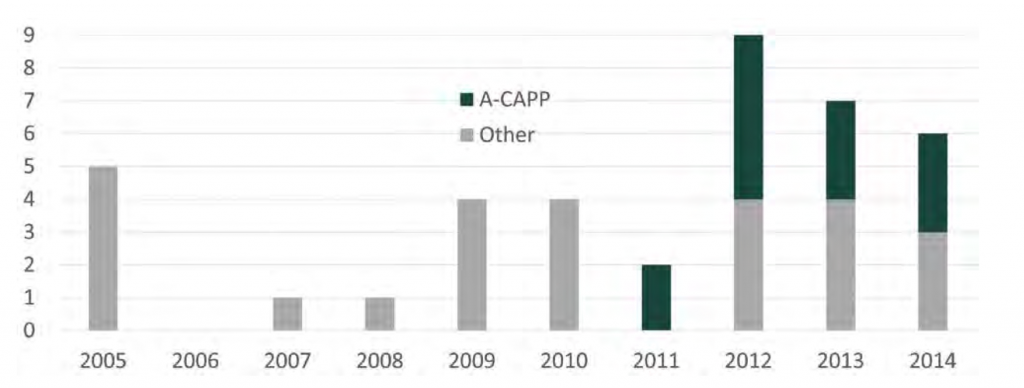Brandon A. Sullivan, Fiona Chan, Roy Fenoff and Jeremy Wilson, 2017
For researchers to advise efforts to combat product counterfeiting, they must first establish what is known about it. As a first step in doing so, A-CAPP Center researchers conducted a content analysis of 47 articles discussing product counterfeiting and published in criminal justice and criminology journals through 2014. This backgrounder summarizes characteristics of these articles and recommends paths for future research.
Although it has grown in recent decades, product counterfeiting research is still at a primitive stage. This is evident from the infrequent and sporadic publication of studies on it, the diverse range of publication outlets for this research, and broad coverage with limited depth of discourse in any subarea.
Existing product counterfeiting literature typically centers on a few key areas. The first is the scope and magnitude of the problem. The second is the risks and opportunities for product counterfeiting. The third, and least developed, is identification and prevention mechanisms for various industries.
Research to date has provided a baseline understanding of product counterfeiting but is limited in its quantity and quality. Among the challenges to improving this research are the difficulties in classifying product counterfeiting as a crime and in quantifying it. Among the reasons for these challenges are the lack of research by scholars in criminology and criminal justice (CCJ) journals on the problem.
We sought to better understand the limited nature of CCJ research on product counterfeiting and where it might be improved. Accordingly, we conducted a content analysis of English-language articles on product counterfeiting published in academic CCJ journals through 2014.
Numbers of Articles and Authors
Altogether, we identified 47 articles explicitly addressing product counterfeiting that were published in CCJ journals through 2014. Of these, 29 had a primary focus on product counterfeiting. The remaining 18 discussed product counterfeiting among other issues, such as among types of crime linked to an organized crime group.
These 47 articles appeared in 23 different CCJ journals. More than one in four appeared in one of two journals: the International Journal of Comparative and Applied Criminal Justice and Trends in Organized Crime. These each published six articles on counterfeiting, most of which were through special issues we discuss below.
Of the 23 CCJ journals featuring product counterfeiting articles, only 10 have impact factors recorded. These 10 journals published 19 of the articles. Although unranked journals may be important within their sub-field, their influence in terms of citations cannot be directly compared to other journals.
We found the first CCJ article on product counterfeiting was published in 1985, with only seven more articles published through 2004. Since then, the number of articles has risen sharply (see Figure 1).

Figure 1: Number of CCJ Counterfeiting Articles by Year and Authorship, 2005-2014
The first uptick occurred with a special issue of Trends in Organized Crime in 2005, which accounted for four of the five articles published that year. A second uptick occurred with a special issue of the International Journal of Comparative and Applied Criminal Justice, which accounted for four of the nine articles published that year.
Finally, A-CAPP Center affiliated researchers have published 13 articles in these journals since 2011. Put another way, A-CAPP Center researchers accounted for most CCJ articles on product counterfeiting from 2011 through 2014, and for nearly one-fourth of all such articles since 1985.
These 47 articles had 77 authors. Nearly half (35) of these were affiliated with U.S. institutions, but institutions from ten other countries were represented as well. Institutions in the United States, the United Kingdom (19 authors), and Italy (9) accounted for nearly five of six authors of these articles. Our focus on English-language articles likely explains much of the prominence of authors affiliated with U.S. or UK institutions in these articles.
Nearly three-fourths (57) of the 77 authors were affiliated with a university. Only 11 of the 77 authors published more than one article on the topic.
The number of authors per article ranged from one to five, with a mean of 2.0. References per article ranged from zero to 175, with a mean of 56.1. Length of articles ranted from 2,600 to 13,000 words, with a mean of 7,800 words.
Approaches and Topics
Among the 47 articles, 28 were non-empirical. Seven of the non-empirical articles were theoretical contributions; 21 were general discussions of crime or justice issues related to product counterfeiting in some way but lacking empirical analysis.
Among the 19 articles using empirical methods, 10 used quantitative methods, 2 used qualitative methods, and 7 used both qualitative and quantitative methods.
While “counterfeit” (or a variation) was the most common word used to refer to product counterfeiting, other terms were common as well. Among the more common (including variations of each) were “intellectual property,” “trademark,” and “fake,” with each appearing in at least 30 articles.
Conversely, those articles that used “counterfeit” and related terms less frequently were more likely to use crime-related terms. This suggests product counterfeiting may be less associated with crime than other types of articles.
Among the most common stated purposes of these articles was the need to understand product counterfeiting and its underlying processes. Many focused on counterfeiting in a specific context (e.g., location or industry). The articles centered on the importance of addressing intellectual property crime as it relates to counterfeiting. Another common theme was the legal landscape and enforcement of trademark counterfeiting laws.
Numerous articles pointed to the limitations of current research and data sources, with some seeking to critique current estimates. Such work noted the need for both qualitative and quantitative methods.
Several articles focused on advancing theories related to product counterfeiting. One prominent area of theorizing centers on understanding the opportunities for engaging in product counterfeiting. Others focused on the economics of crime, particularly as it related to consumer behavior.
A final purpose of several articles was to inform and advance anti-counterfeiting policies and practices. Yet implementing many of these would confront the challenges inherent to the study of counterfeiting.
Challenges to studying product counterfeiting identified in the research include definitional differences, availability of appropriate data sources, and incomplete or inaccurate measurements.
Among the definitional challenges are determining what constitutes counterfeit rather than intellectual property issues. The lack of common definitions poses challenges both to responding to the problem and the ability of researchers to establish its scope and impact.
The lack of data on counterfeiting reflects its status in the underground economy. It is difficult to access offenders, who typically do not want to be uncovered or share information. Even when data are available, they may not be easily accessible to researchers.
Finally, published research notes problems with incomplete or inaccurate measurements.
Estimates typically rely on seizure data, which only reveal what has been intercepted by customs officials, not all that has been manufactured or sold. Seizure data may also vary with enforcement efforts. Gathering victimization data, a common method for assessing other crimes, is difficult for counterfeiting because many victims may not know they were victimized.
Directions for Future Research
Our analysis makes clear that knowledge of product counterfeiting as a crime remains limited. Work to date has focused on building a general understanding of the problem. Yet the need for identification and prevention techniques, as well as common definitions and measures, remains. Theoretical development lags behind other areas of crime and justice.
Published research notes many possible directions for future research. One approach would be to assess how counterfeit products are introduced into the supply chain. Such research might focus on the intersection between supply chain risk management theories and criminological theory. Another approach would be to integrate situational crime prevention with other criminology theoretical perspectives. Published research has proposed myriad individual topics as well, with some suggesting the need to study the problem from multiple perspectives.
While product counterfeiting has not received adequate attention in academia for a variety of reasons, this has begun to change over the last decade. Legal attention to the problem, as reflected in the Prioritizing Resources and Organization for Intellectual Property (PRO- IP) Act of 2008 and enforcement efforts of the National Intellectual Property Rights Coordination Center, has helped focus attention on the problem. So have efforts by private organizations such as the U.S. Chamber of Commerce Global Intellectual Property Center (GIPC). Joint public and private efforts such as that between Interpol and UL (Underwriters Laboratories) in creating the International IP Crime Investigators College have also occurred.
As this research continues to grow, replicating the analysis summarized here may be helpful. For example, our research found few articles on counterfeiting were published in CCJ journals with an impact factor. It may be that few articles on the topic have been submitted to such journals—and that more will be submitted, and published, in such journals as research on this topic grows.
Extending this research in two ways may help better establish a foundation for future anti- counterfeiting initiatives. First, our focus on English-language publications may have caused us to overlook important research. Analysis of research in other languages, as well as on author backgrounds beyond organization affiliation, may be necessary to assess the full extent of understanding of the problem.
Second, research similar to that reported here but done in other disciplines such as medicine, psychology, business, or law, could help identify similarities and differences in how product counterfeiting is studied. It could also help identify potential areas of cross-disciplinary collaboration and integration. By obtaining a more complete picture of what research has, and has not, been completed on product counterfeiting, scholars can better focus their research efforts.
2017 Copyright Michigan State University Board of Trustees
The research reported in this backgrounder is documented in Brandon A. Sullivan, Fiona Chan, Roy Fenoff, and Jeremy M. Wilson, “Assessing the Developing Knowledge-base of Product Counterfeiting: A Content Analysis of Four Decades of Research,” Trends in Organized Crime, published online December 30, 2016 at http://link.springer.com/article/10.1007/s12117-016-9300-5.
